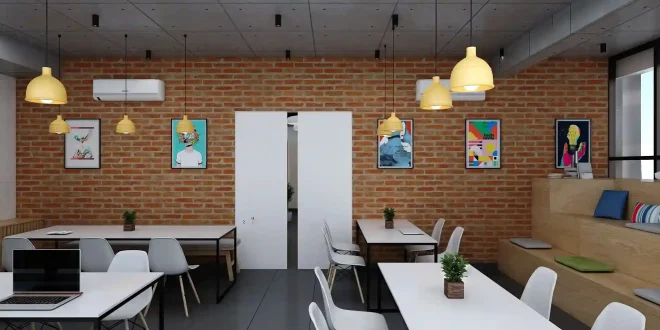Introduction
In today’s fast-paced business environment, commercial interior design has evolved to meet the growing demands of functionality, aesthetics, and comfort. Whether you’re designing a corporate office, retail space, or hospitality venue, modern commercial interior design plays a crucial role in shaping the overall atmosphere and experience of both employees and customers. The right design not only enhances the visual appeal but also boosts productivity, creativity, and brand image.
This article explores innovative ideas for modern commercial interior design that will help businesses transform their spaces into functional, stylish, and efficient environments. These tips will cover everything from space planning and furniture selection to lighting and sustainability, ensuring that your commercial space is both practical and visually captivating.
1. Embrace Open and Collaborative Spaces
The traditional office layout with cubicles and isolated workstations is quickly becoming a thing of the past. Modern commercial interior design emphasizes open and collaborative spaces that foster creativity and teamwork. This shift toward more flexible and dynamic layouts is designed to encourage communication, collaboration, and innovation.
- Open Workstations: Replace cubicles with open desks or modular workstations to create a more fluid environment where employees can freely interact.
- Breakout Areas: Design designated spaces where employees can take informal meetings or collaborate on projects. These areas can feature comfortable seating, writable walls, and flexible layouts.
- Creative Zones: Incorporate areas where employees can brainstorm, engage in creative activities, or relax. These spaces often feature creative furniture, vibrant colors, and interactive elements.
- Flexible Conference Rooms: Invest in movable partitions and modular furniture to transform rooms based on the team’s needs. Larger rooms can be divided for smaller group discussions.
The open-plan design encourages interaction, allowing employees to feel more connected to one another, which can enhance overall productivity and morale.
2. Incorporate Biophilic Design Elements
One of the most impactful trends in commercial interior design is biophilic design. This concept focuses on bringing natural elements into the workspace to improve well-being, reduce stress, and increase productivity. By integrating plants, natural light, and organic materials, businesses can create a calming and inviting atmosphere.
- Indoor Plants: Adding a variety of indoor plants to your commercial space not only improves air quality but also adds visual appeal. Consider large statement plants or hanging planters.
- Natural Lighting: Maximize the use of natural light by installing large windows or skylights. In spaces with limited natural light, use light therapy lamps to simulate daylight.
- Wooden Finishes and Natural Materials: Incorporate wooden furniture, floors, and wall panels for a warm, organic feel. Materials like stone, clay, and bamboo also help to create a natural ambiance.
- Water Features: Integrating small indoor fountains or water walls can further enhance the tranquil, natural atmosphere.
Biophilic design is more than just a trend; it’s a design philosophy that can significantly improve employee satisfaction, focus, and overall wellness.
3. Use Smart Technology for Efficiency
Incorporating smart technology into commercial interior design is not only practical but also adds a futuristic touch to your space. Smart technology can help streamline operations, increase energy efficiency, and enhance the user experience.
- Automated Lighting and Temperature Controls: Install smart lighting and temperature control systems that automatically adjust based on time of day, occupancy, or weather conditions. This reduces energy consumption and keeps the space comfortable.
- Interactive Digital Displays: Digital signage and interactive touch screens can be used for wayfinding, displaying important company information, or creating an interactive customer experience.
- Smart Office Equipment: Invest in smart desks, chairs, and meeting equipment that adjust according to user preferences. This promotes ergonomic comfort and enhances productivity.
- Security Systems: Modern security technology, such as facial recognition systems, smart locks, and surveillance cameras, can enhance safety while also offering convenience.
Integrating smart technology into your commercial space not only boosts functionality but also demonstrates a commitment to innovation and efficiency.
4. Sustainable and Eco-Friendly Design
Sustainability is a key consideration in modern commercial interior design. As businesses become more environmentally conscious, eco-friendly design choices are gaining popularity. Sustainable design not only benefits the planet but can also reduce operational costs in the long term.
- Recycled and Upcycled Materials: Use furniture and finishes made from recycled materials such as reclaimed wood, recycled glass, or upcycled metal. This reduces the environmental impact and can give your space a unique, industrial look.
- Energy-Efficient Lighting: LED lights and energy-efficient lighting fixtures reduce electricity consumption while providing bright and consistent illumination.
- Sustainable Furniture: Choose furniture made from sustainable materials or brands that prioritize eco-friendly manufacturing processes.
- Water Conservation: Install water-saving fixtures like low-flow toilets, water-efficient faucets, and motion-sensor taps to reduce water consumption.
By prioritizing sustainability, you not only create a more eco-friendly commercial space but also demonstrate your company’s commitment to social responsibility.
5. Integrate Multifunctional Furniture
As commercial spaces become more compact and versatile, multifunctional furniture is becoming an essential part of modern interior design. This furniture helps maximize space without sacrificing style or comfort.
- Modular Furniture: Modular seating systems, desks, and tables can be rearranged to meet the specific needs of your team or visitors. This flexibility is particularly useful in open-plan offices or multi-purpose spaces.
- Convertible Desks and Workstations: Choose desks and workstations that can be easily adjusted or converted into different configurations, such as standing desks or desks that transform into collaborative workspaces.
- Storage Solutions: Look for furniture that includes built-in storage, such as desks with drawers, storage ottomans, and cabinets that double as room dividers.
- Space-Saving Furniture: Consider foldable or stackable furniture that can be stowed away when not in use, making the most of limited space.
Multifunctional furniture is perfect for businesses that need to optimize limited space while maintaining a stylish and professional environment.
6. Focus on Branding and Identity
Commercial interior design offers a unique opportunity to reinforce your brand identity and create a cohesive and memorable experience for clients, visitors, and employees alike. Every element of your space—from colors and materials to signage and artwork—should align with your brand values and message.
- Logo Integration: Incorporate your company’s logo and brand colors into the design, whether on walls, furniture, or signage.
- Branded Walls and Artwork: Consider large-scale murals, artwork, or custom designs that reflect your company’s ethos and values.
- Consistency Across Spaces: Ensure that branding elements are consistent throughout all areas of your commercial space, including the reception area, meeting rooms, and break areas.
- Custom Furniture and Fixtures: Create bespoke furniture pieces or fixtures that align with your brand’s visual identity. This can include custom-built shelving, tables, or chairs in your brand colors.
A well-branded commercial space helps clients and employees feel connected to the company and fosters a sense of belonging and pride.
7. Minimalistic Design with Clean Lines
Incorporating minimalism into commercial interior design is one of the most effective ways to create a modern and sophisticated space. By focusing on simplicity, clean lines, and a clutter-free environment, you can create a calming and efficient workspace.
- Neutral Color Palettes: Choose neutral colors like whites, grays, and beiges to create a calm and professional atmosphere. These can be accented with subtle pops of color for added visual interest.
- Streamlined Furniture: Opt for sleek, modern furniture with minimal ornamentation. Choose simple desks, chairs, and storage units with clean lines and functional designs.
- Open Layouts: Avoid overcrowding the space with unnecessary furniture. An open layout with plenty of breathing room encourages focus and productivity.
- Decluttered Spaces: Keep the space tidy by using hidden storage solutions and avoiding excess decoration.
A minimalist approach creates a timeless design that is not only modern but also functional and easy to maintain.
Conclusion
Innovative commercial interior design is all about creating spaces that are both functional and inspiring. By embracing open layouts, biophilic design, smart technology, sustainability, and multifunctional furniture, businesses can create environments that enhance productivity, creativity, and overall employee satisfaction. Incorporating your brand’s identity and keeping the design minimal yet stylish ensures that your space is not only attractive but also aligned with your company’s values and goals.
Whether you’re designing a corporate office, a retail space, or a hospitality venue, modern commercial interior design offers endless opportunities to create spaces that work for you. Prioritize comfort, flexibility, and innovation, and watch your business thrive in an environment that fosters success.
 Crypto trade Online Unlock the Future of Finance Today.
Crypto trade Online Unlock the Future of Finance Today.




